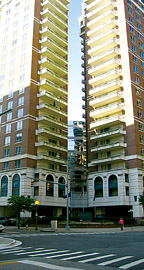In 2002, Lincoln Towers hired a team of engineers from Consolidated Engineering Services, Inc., an Arlington-based firm, in conjunction with Holman Boiler Repair of Springfield, to remedy the problem by relocating the hot water and heating plants to the complex's underground parking garage. The arrangement presented two large hurdles. Only five parking spots (600 sq ft) had been set aside in which to build the new heating plant. The location was not only small, it was also underground and more than 150 ft away from one of the apartment towers.
"Given the small space we had to work with, a combination system using high-efficiency boilers to support both space-heating and domestic hot water requirements from a single plant was the best solution," said Andrew Huck, who served as the senior engineer on the project. "This approach reduced the construction budget and offered the customer long-term fuel savings."

Reduced Plant Capacity Minimizes Project Costs
The Consolidated team installed 10 AERCO Benchmark boilers in the new space to serve as the system's anchor. "The original design, with separate boilers and water heaters atop each tower, provided more than 28 MBtuh total capacity," said Huck. "By combining the space- and domestic-water heating loads, and consolidating the plant in a single location, we were able to effectively support the complex with a 20 MBtuh capacity plant. This dramatically reduced the overall cost of the project."A combined system will always be a fraction of the size of independent space and domestic hot water plants. Dedicated space-heating plants are engineered for the lowest possible outdoor temperatures, which may occur for just a few hours on one or two winter nights during an entire heating season. All the remaining days of the year, this extra capacity can be working to support the domestic-heating load. Especially in an apartment building, demand for both space heat and hot water will virtually never peak simultaneously.
"This idea is most effectively demonstrated in a typical AERCO combined system installation, where one or more boiler units literally swing back and forth between dedicated support of the domestic-water-heating system and standby availability to support increased space-heating demand," explained Huck. "But such an approach would have required separate piping loops - one for the space heating and one for the domestic hot water - to be run to each of the towers. Whatever savings we had reaped in terms of boiler equipment would have evaporated in the face of piping expenses. To keep costs low, we reverted to a more conventional design approach."
A Consolidated Design
The engineering team decided to run one set of pipes to the pre-existing mechanical rooms that existed in each tower. The new boiler plant provides constant 160°F supply water to support each building's heat pump and domestic hot water systems.Each building employs a water source heat pump loop for space heating. Designed to run with 70° water, the space-heating loop uses temperature sensors, situated downstream of the boiler loop supply, to activate modulating two-way control valves to ensure constant temperatures. When loop temperatures rise beyond acceptable limits during warmer days, the water from the loop is routed to a cooling tower located on the roof of each building. If loop temperatures get too cool, the control valves open to inject the 160° boiler supply water into the heat pump loop as needed.
Each building employs a domestic-water, double-wall, plate-and-frame heat exchanger and a 200-gal storage tank to support its domestic hot water requirements.
To maximize fuel savings, plant operation is coordinated by AERCO's Boiler Management System, which ensures that boiler plant output exactly matches system demand while maximizing the number of units - all operating at the lowest possible firing rate - in operation.
"The one major advantage of the underground plant was that we were able to easily vent the boiler plant directly into the parking garage's pre-existing ventilation system," said Huck. "Since the new plant went online at Lincoln Towers, the days of cold apartments and cold showers are gone." ES
